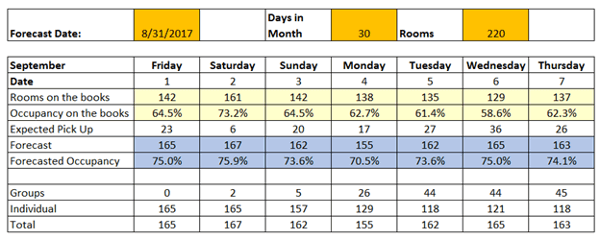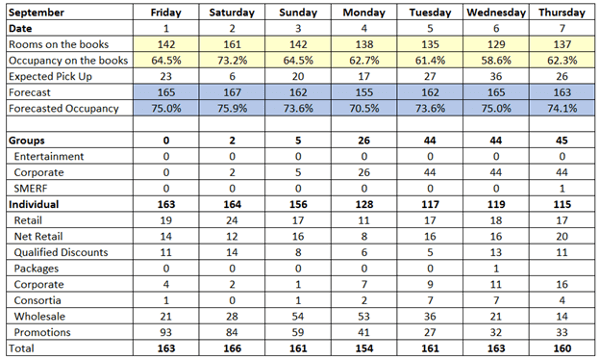
Recently, we released five revenue management hacks. These hacks are designed to be simple things you can put into place whether you are using automated tools or working in a manual environment. This post examines how understanding future demand can help you better manage operational forecasts.
NB: This is an article from Rainmaker
Time is a luxury for hoteliers. Every single day we are asked to do more with less. As a result, we often look for ways to streamline our processes. One place this streamlining occurs is in forecasting. Often hotels will opt to look only at an operational forecast without truly understanding what is fueling this forecast.
Even within the operational forecast, we frequently consolidate even more for efficiency purposes. Revenue managers often choose to forecast just at the daily total (example 1). And this works for a forecast being disseminated for staffing. It gives managers exactly what they need to schedule appropriately.

However, this forecast doesn’t allow for the revenue manager to understand the composition of the revenue. Which means, the revenue manager has no insight into how the forecast will contribute to the profitability of the hotel. This can be alleviated, to some extent, by broadening the operational forecast to understand the makeup of the forecast (example 2).

But to be able to manage mix and thus profitability, you need to be able to understand demand. Starting at this level of forecast provides a clear understanding of what could happen, making it easier to manage what will happen. On any given day, despite the occupancy forecast, managing the mix is how a hotel can truly impact profitability.
Understanding demand at this level allows hotels to manage their segmentation and even channel mix to achieve optimal rate mix for any demand period. What levers can or will you pull to get to the best occupancy?
A demand forecast helps you better understand what is possible which helps unlock the potential. Done properly, it helps you better manage the flow of business to create the most profitable mix of business. Additionally, it can help fuel more accurate operational forecasts, and who doesn’t like being more accurate?




